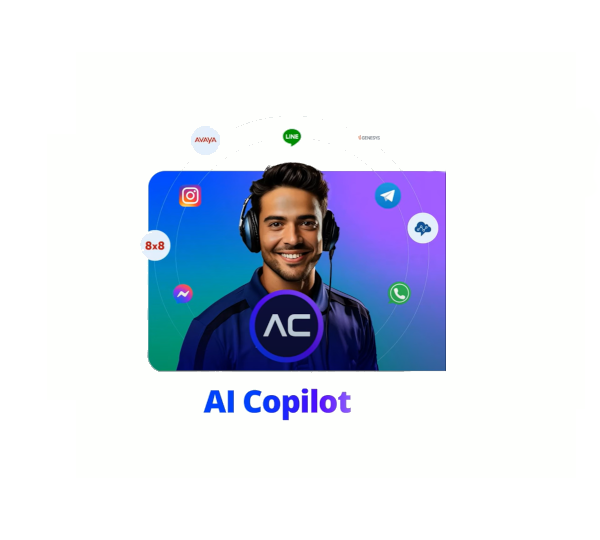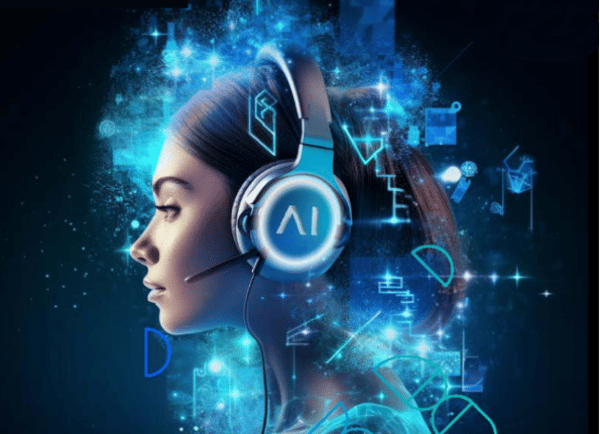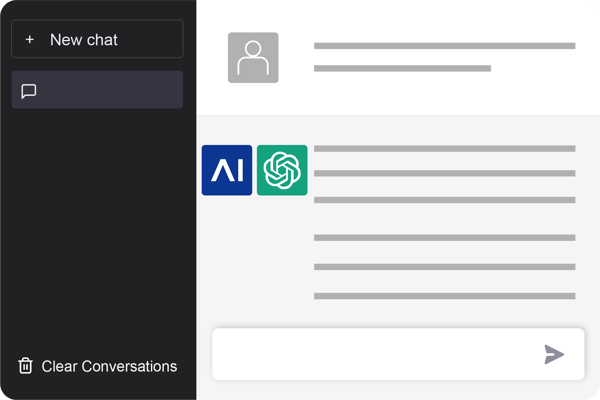How AI chatbots can improve your customer experience
The age of the artificially intelligent chatbot has arrived, and with it, resistance to the idea of automation in the contact center is crumbling. As consumers and contact center managers come to fully understand the true role of the AI chatbot for customer service, the benefits they bring can be realized, and fears laid to rest.
Customers expect a seamless and frictionless 24/7, anytime, anywhere, any-channel experience. AI-powered virtual agents operating across all digital and voice channels fill this need perfectly. AI virtual agents will present a consistent brand message and use a precisely pitched voice that takes on a personality that speaks to your customer's needs, facilitating conversations that lead to a swift resolution.
There has been a 460% growth in web chat automation since 2015. In addition, nearly nine out of ten consumers (88%) think that AI will be used to support agents in the contact center. So, how can AI chatbots improve customer experiences in your organization?
Related content:
What is an AI chatbot (and how could I use it?)
An AI-powered chatbot is exactly what it says on the tin: a virtual robot designed to "chat" with people and analyze the interaction to determine what the person needs and how to provide it for them. However, unlike a simple "bot," which operates without human-bot interaction, the AI-powered chatbot will evolve through learning, spot trends, predict intents, and leverage knowledge to pursue service excellence.
While artificial intelligence is continually improving, it works best when designed to address specific customer problems in a particular industry. For example, an AI chatbot developed for a bank will not be helpful for a company that sells window blinds. Moreover, even a chatbot developed for a bank will not be particularly good at carrying on a human-like conversation with banking customers if the topic strays from actual banking matters.
Your AI chatbots will have chatty conversations with your customers about the weather or ask after their favorite pet. What they will do, what they are designed to do, and what they are good at is improving the experience customers have with your organization.
AI chatbot functions
A customer service chatbot can gather information about a customer and pull up their account or start a file for the customer service representative (CSR). Also, the chatbot can figure out if the customer needs help with a simple problem that can be handled in seconds and resolved satisfactorily or if they have a complex issue that requires the expertise of a specific person in your call center.
An intelligent chatbot powered by conversational AI can glean information from a short initial interaction with a customer and route the chat to the correct destination for speedy handling. It can even flag a conversation as potentially sensitive or let the CSR know that the incoming call will be with a customer who is already borderline abusive.
Armed with this information, the CSR gets in front of the problem and can defuse and address the situation more efficiently to ensure a swift and effective resolution. For example, if your desired outcomes are consumer satisfaction and customer retention, AI chatbots can help make that happen.
How an AI chatbot can help customer service teams
Chat is here to stay. A whopping 25% of web chats are handled in less than three minutes, compared to only 9% of phone calls. That kind of efficiency is a core driver for chatbot adoption in contact centers today.
However, many contact center managers wonder if they bring in AI and chatbots, what happens to their employees? Will AI-powered contact centers become ghost towns populated only by bots? The truth is, it's not about cutting core staff. It's about increasing efficiency and productivity and driving customer satisfaction and brand loyalty through improved customer service. With AI-powered chatbots providing robust support, the benefits include:
- Reducing time-to-resolution for better customer experiences
- Relieving representatives of repetitive, mundane tasks for better employee experiences
Bottom line: AI chatbots will never replace your customer service representatives. However, chatbots and customer service representatives can and will work together. For example, an AI chatbot can be used as an entry point for customers, identifying their issue and either helping them resolve it or correctly routing it to the right CSR on your team.
The chatbot can conduct the entire customer interaction for many routine and repetitive tasks. These tasks are many and varied. For instance, a chatbot in a bank can provide balance information, verify a transaction, reset a password or help with a complete transfer between accounts.
An AI chatbot can even be looped in and be present in the background during CSR interactions with customers. The chatbot assumes a support role and can offer suggestions or present relevant information to help the CSR complete the call.
Studies show reduced handle times of up to 10% for interactions managed by agents assisted by a chatbot powered by conversational AI, which uses natural language processing to anticipate and predict customer needs and wants.
Just one terrible experience can cause a customer to leave your brand for good. In contrast, consumers stay and spend up to an average of 57% more on brands they feel loyal to. Increased retention means increased revenues. The AI chatbot you choose can make or break customer experiences, determining whether they stay and become even more loyal or move on.
Implementing AI chatbots for customer service
Training an AI chatbot to work effectively is a complex process. The AI chatbot needs to draw on all available data to inform the practical side (making a knowledge base available to the AI for training purposes) and the interactive side (using natural language processing to power conversational analysis in real-time.)
Deep learning allows custom-built- AI chatbots to improve continually, taking the results of each interaction and analyzing them to figure out which approaches work best and how to use language cues to discern deeper meanings in customer communications.
All of the learning processes aren't just on your AI chatbot's side. As customers become more accustomed to dealing with chatbots and automated systems, they also learn how to get the best results from their interactions.
Just as web search users have learned how to word their queries to get the best results from a Google search, chatbot users are figuring out how to communicate with artificial intelligence to get their point across.
Implementation of an AI chatbot
AI technology supports your customer service team, whether your chatbot is integrated into your website and pops up when a customer enters to ask if they need virtual assistance or if it only appears when a customer seeks to initiate a customer service interaction with a CSR.
It's up to you how you choose to deploy your AI chatbot. For some contact centers, using it as a front line of service could be the best move, particularly if a significant percentage of customer service queries are simple password resets or account balance requests.
Alternatively, you can offer virtual assistance from an AI chatbot while your customer is waiting for a live CSR. Using an AI chatbot for voice calls is a way to potentially solve their issue more quickly or as a mode of information gathering, to make their CSR-based interaction run more smoothly.
Choosing the right chatbot solution for you and your team
Wondering how to choose the right AI chatbot to help drive success in your contact center? The first step is deciding which business processes you want your chatbot to automate. From there, you can determine what kind of chatbot will best serve your purposes:
Rule-based chatbot
This type of bot is extremely limited. It has clear rules that dictate what questions can be asked of it and what answers it can give. This kind of chatbot should always have a termination point that sends the customer directly to a live CSR when the bot cannot handle the presented issue.
Machine learning chatbot
A machine learning chatbot has a little more capability and can work with a customer to determine their issue outside of the more rigid constraints of a rules-based bot. While machine learning chatbots may not have full AI capability, they can accept new data and use it to inform future interactions.
Conversational AI chatbot
A conversational AI chatbot is the most technologically advanced chatbot. It uses natural language processing to create human-like interactions (within the parameters of the chatbot's scope.) An AI chatbot can increase your team's usable data by encouraging your customers to share information and then using that information to develop and deploy customized experiences.
Choosing a chatbot vendor
There are key questions you should ask your potential AI chatbot provider if you are thinking about adding conversational AI-powered chat to your contact center.
-
Inquire about the vendor's capability to build end-to-end customer journeys across all of your support channels. For example, will the data gathered by an AI chatbot be available to a CSR taking a phone call from the customer? Omnichannel support is a must-have.
-
Is interoperability a feature? For example, when there are multiple chatbots, will they synchronize and work together to offer a seamless and frictionless environment?
-
Also, ask about failover (handoff to a live CSR). Is it correctly optimized to transfer chats at the best time - neither too early, wasting valuable resources, nor too late, by which time the customer is annoyed and frustrated?
The right vendor will handle all of your questions confidently and describe how they manage these critical issues.
If you are ready to explore adding AI chatbot capability to your contact center, contact Cognigy for a demonstration today.

.png?width=60&height=60&name=AI%20Copilot%20logo%20(mega%20menu).png)




.png?width=600&height=600&name=Knowledge%20AI%20Feature%20image%20(2).png)













